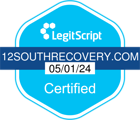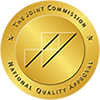Fentanyl is a synthetic opioid used to treat short and long-term pain, typically administered orally or via slow-release patch and given by prescription.

The drug is extremely potent at an average of 50-100 times but up to 10,000 times the strength of morphine. When taken orally or injected, fentanyl causes feelings of euphoria and lowered inhibitions, leading to rampant recreational abuse.
Fentanyl is increasingly regulated for medical use, but is extremely popular as a street drug thanks to its increased potency, reducing the cost per dose. With a similar profile and effect to other street drugs such as heroin and morphine, as well as to pain pills such as Percocet, codeine, and oxycodone, fentanyl abuse is often a natural extension of other opiate abuse. The fentanyl epidemic has been slowly increasing over the past 20 years, tracking extremely well with rises in opioid overdoses and the rise in opioid popularity as a recreational drug.
If you or a loved one is using, it’s important for you to understand how overdoses happen, how often the happen, and what risks are. It’s also important to seek out help for drug addiction, because Fentanyl can be deadly.
Deaths Caused by Fentanyl Overdose
In 2017, 72,000 Americans died as a result of a drug overdose, up more than 8,000 cases, or 12.5% from 2016. This spike follows a trend in rising rates of overdose, as strong opioids like fentanyl become more popular, leading to a rise from 40,000 overdose related deaths in 2011 and 20,000 in 2001. This significant increase has made opiates one of the number one causes of death in the United States, outnumbering car and gun related deaths combined.
Fentanyl and other synthetic opioids were responsible for 29,000 of these deaths according to the CDC, thanks to increased strength, difficulty in dosing, and contamination of lighter opioids with stronger ones such as fentanyl. Considering that opioid-overdoses make up just over 40,000 of all drug-related deaths, fentanyl and other similar-strength synthetics are responsible for a vast majority of opioid related deaths in the USA.
In 2019, deaths involving synthetic opioids other than methadone (primarily fentanyl) continued to rise with more than 36,359 overdose deaths reported in 2019. From June 2019 to May 2020, the USA experienced the highest number of overdose deaths ever in a 12-month period. Illegally manufactured fentanyl appears to be the driving force behind the increase in overdose deaths, according to the CDC.
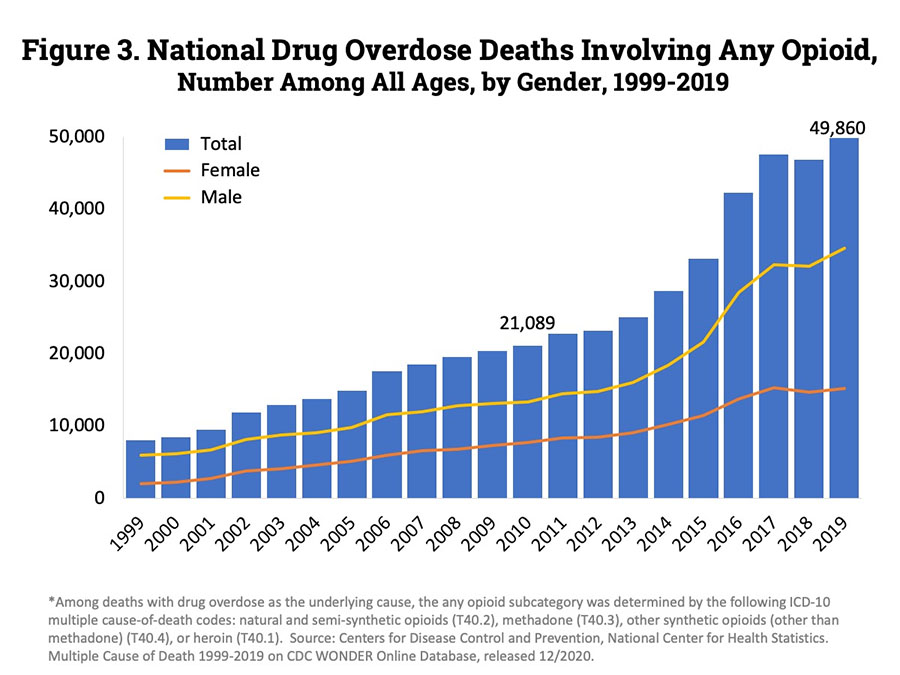
Opioids are Rising in Popularity
Opioid drugs, especially pain pills such as Percocet or oxycodone, are becoming increasingly more popular. Even heroin is rising in popularity, often used as a substitute for prescription drugs by individuals who are addicted but who can no longer access their drug of choice. The U.S. Department of Health and Human Services suggests 11.5 million people abuse prescription opioids and over 2.1 million are addicted to prescription opiates.
Illegal street use is often rampant, with dealers selling both imported and synthetically manufactured opiates and pain pills, stolen or purchased from doctors and prescription users. The result is a wide availability of most drugs in the class, leading to increased abuse and addiction.
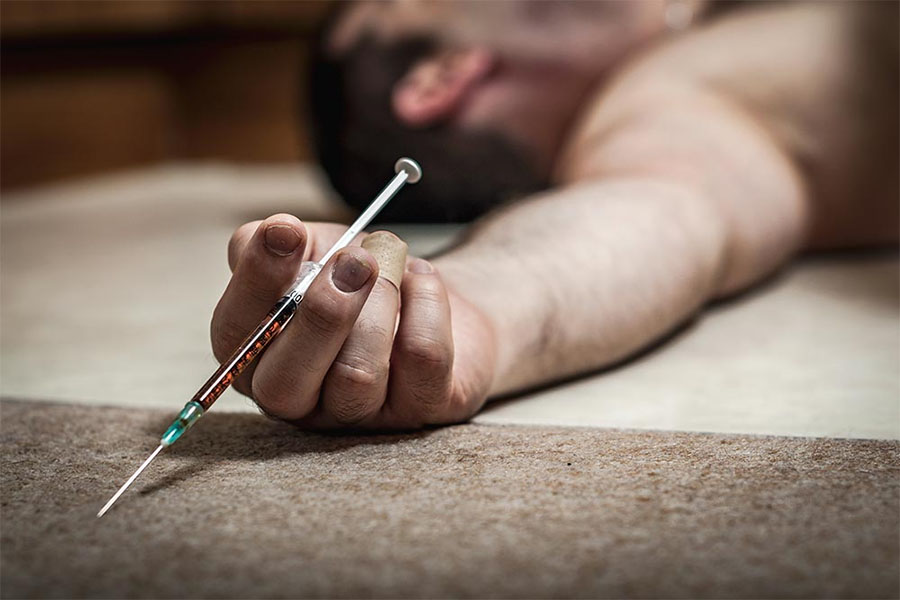
Why are People Overdosing on Fentanyl?
With a nearly 200% increase in opioid related deaths between 2001 and 2017, how, when, and why Americans use opiates is changing. More individuals are using opiates recreationally, more are abusing prescriptions, and most importantly, the drugs are cheaper and more readily available than ever before. With increasing crackdown on prescription opiate abuse, leading to better regulation of prescription medication, many are also turning away from relatively safer set doses of opiates and towards street-manufactured and produced drugs which are much more difficult to dose properly.
For example, fentanyl frequently contaminates other drugs, simply because even a tiny amount of residue on a table used to cut or bag drugs would lead to contamination. At more than 100 times the strength of morphine, even a slight contamination of an opiate such as heroin with fentanyl would result in a potential overdose. Similarly, several states discovered fentanyl lacing cocaine and other drugs, leading to a significant increase in overdose deaths for those drugs.
Some dealers may also intentionally lace their drugs with a more potent opioid, allowing them to cut the existing drug much further, reducing their total costs and increasing how much they are able to sell.
Difficulty Dosing and Increased Dosing with Tolerance
Drug tolerance and dosing are possibly the most pressing concerns behind fentanyl overdoses, simply because the problem effects all users. Fentanyl is extremely potent and even a tiny overdose can be fatal. Most fentanyl is dosed in 10-50 micrograms, versus a standard daily dose of about 465 milligrams of heroin per day. Reducing the administered dose by about 200% is extremely difficult for many, especially when that person is already intoxicated. This is especially important considering most street-use fentanyl is injected rather than taken with a (much safer) patch or dosed lozenge.
At the same time, many people develop tolerance to drugs, where the body adapts to certain levels of a substance in the system and no longer produces the same neurotransmitters in response. Many people adapt quickly, leading to a decrease in euphoria and pleasure from drug use after just a few doses. Most users eventually increase their dose, which, over time, can become deadly.
Illicitly Manufactured Fentanyl
While fentanyl prescriptions have not increased, fentanyl use and abuse has. This is largely due to illicitly manufactured fentanyl, otherwise known as IMF. Here, fentanyl is synthesized independently. According to the DEA, China and Mexico appear to be the main sources of illicit fentanyl. Based on seizures, the data supports the conclusion that China supplies lower volumes of high-purity fentanyl and Mexico supplies higher volumes of fentanyl that is lower in purity. Other sources include in drug labs in rural areas in the United States, or Central or South America. Without proper quality control or inspection, IMF wildly varies in potency and quality, with some testing at up to 1000 times the strength of morphine. This range in quality and potency means that individuals may easily overdose by taking a safe dose once and then overdosing on a stronger “batch” from the same supplier.
The CDC reports that IMF seizure went up by over 426% between 2015 and 2016, reflecting an increase in manufacture and distribution.
Getting Help for Opioid Abuse
The increase in opioid related deaths in the United States tracks very well to the increase in popularity of fentanyl to treat pain, leading many to advocate for its removal from prescription medication altogether. Today, millions of people suffer from an opioid use disorder, abusing both prescription pain pills and illegally manufactured street drugs. If you or a loved one is suffering from a substance use disorder, there is help. Modern drug addiction treatment offers full support, including medically supported detox to help individuals withdraw from opioids in comfort and dignity, a range of science-based treatment including behavioral therapy and counseling to help individuals recognize where behavior contributes to substance abuse.
Fentanyl is causing increasingly severe harm to users, even those who begin using it according to a prescription. While not inherently bad because many people require it for pain relief, users should carefully manage their usage, discuss use with a doctor, and seek out help if that usage becomes problematic. Obviously, as described above, illicit Fentanyl is a massive problem.
If you or your loved-one is suffering from addiction, please contact 12 South Recovery at 866-839-6876 – we are here to help. Our unique style of care combined with evidenced based treatment has lead to incredible success rates. We strive to support and guide you during your recovery process to help you achieve your personal goals.


